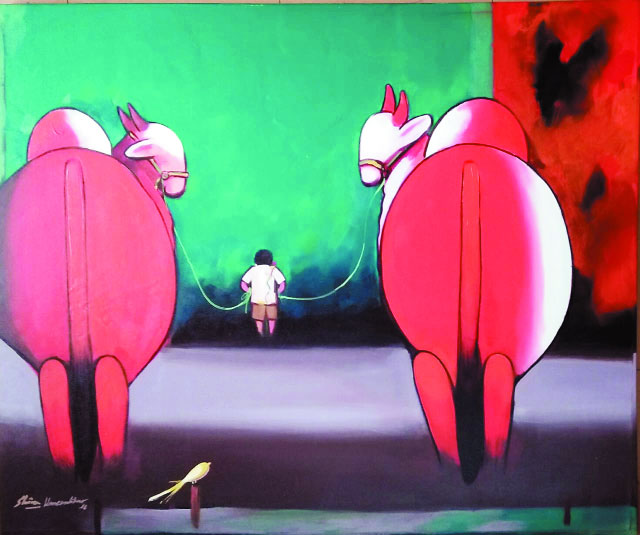According to Rajendra, director and curator, the India Art Festival is not just a display of works by various artists but also a vast collection of representations of rural India.
In the 21st century, the nomenclature of festival is attached to things diverse — whether it is a restaurant serving a cuisine that did not feature on its menu or even a gathering of jazz artists. It does not matter whether it celebrates an occasion or not.
But then there are events like India Art Festival, which was first conceptualised in Mumbai in 2010-11 and celebrates art in all its hues. It is evidence that stories can always inspire and amuse irrespective of the medium through which they are told.
The festival, which was held between November 23 and 25, combined the works of more than 500 artists — from rural, semi-urban and urban cities across the world — bringing in a range of untold stories and expressions. Besides showcasing the works of around 400 established artists, the festival also featured works by over 100 independent artists from cities like Chennai, Jammu, Ahmedabad and Agartala.
The question that arises here is how does such a festival differ from an individual art event and what is the point of having an array of works under one umbrella? “It is a democratic presentation of art that offers emerging and independent artists a platform to showcase their work and help them get noticed.” He feels that most of us frequent galleries and studios of famous artists but forget that there is also a section featuring emerging talent, which is ignored and left unnoticed. He feels that such a festival gives a platform to the artists who are independent, unestablished, away from or not supported by any significant gallery.
In 2009, while he was taking rounds of different art fairs and festivals, he noticed that there was not enough space given to the artists who are not financially secure to associate with a gallery. He also observed that these artists account for a major chunk of the art fraternity and remain unrecognised. He studied that most of the art fairs only featured works from galleries.
He reveals that the festival’s concept was inspired by the New York Art Expo, where works from all kinds of artists were appreciated. There was not a particular “selection criteria” that they followed unlike others. Every type of work was documented there.
“Of course, there are some huge artists as well like Manu Parekh, Satish Gujral, Sanjay Bhattacharya, Swapan Roy, Seema Kohli and more but the independent and emerging artists have also been given around 124 booths,” he says.
A painting by Ramesh Nannaware, titled To the Temple, is inspired by the artist’s childhood when he saw his mother and other women going to the temple everyday.
A sculpture by Nimesh Pilla, titled Flight of Imagination, showcases an angel in wings, his eyes facing towards the sky, his body posture symbolic of an athlete taking the position at the start line of a race. Through this piece, the artist represents that phase of his life when he first gave wings to his imagination as an artist. The wings of the angel are a metaphor of the idea that each one of us nurtures dreams within ourselves but we seldom give them the wings to fly or even the attention that they deserve.
This edition, according to Rajendra, saw a number of marble sculptures which hadn’t been featured earlier. There were two pavilions — one, for the students of a blind school and the second, for the prisoners of Tihar Jail, who have passed out of art school — which were completely new.
Around four to five Tihar inmates were sketching and drawing, when they were spotted by the jail administration. To encourage them, the instructors, who taught them, were contacted. Today, there are over 200 inmates who learn painting, and over 20 have mastered the art in less than two years. Their paintings were also a part of the show.
“The paintings by prisoners of the Tihar Jail weren’t showcased to justify their criminality or defend them in any way but just to encourage a more inclusive society in terms of talent and art. It is also important to exhibit their works outside the Tihar gallery to make them get recognised outside its premises. Such initiatives give those people a new life of refuge and a chance to repent,” believes Rajendra.
The drawings by the visually-impaired children were priced at as low as a rupee to make the them reach more living rooms.
A painting by HR Das, titled Bulls, calls out the beast within. The bulls and cows in his painting don’t just exist but pulsate with energy, effortlessly expressing the sheer strength and beauty of the beast. He distinctly portrays the magnificent animal that is rooted in the Indian psyche, culture and history. Rajendra says that while some artists may tend to overlook the background, Das treats it like a stage in front of which his characters perform.
The painting Small Leader, by Shiva Wanewadikar, is inspired by leadership skills such as will power, strength and self-confidence, which are exhibited by a farmer’s young son who is controlling two big bulls, much larger than his own size. The painting signifies that leadership is not determined by age or size of a person.
Curating such a grand show comes with challenges but Rajendra is pushing the envelope with each edition. “Quality work always comes first. We also worry about footfall but unlike previous years, this factor has improved a lot. With the coming of social media, footfalls are no more a challenge. But the territorial expanse is. We will be finding an appropriate venue in the future,” he says.
Writer: Chahak Mittal
Courtesy: The Pioneer








 OpinionExpress.In
OpinionExpress.In















Comments (0)